
Top 25 Rankings 1901-1935
1923 National Championship
Home
1923
College Football Top 25
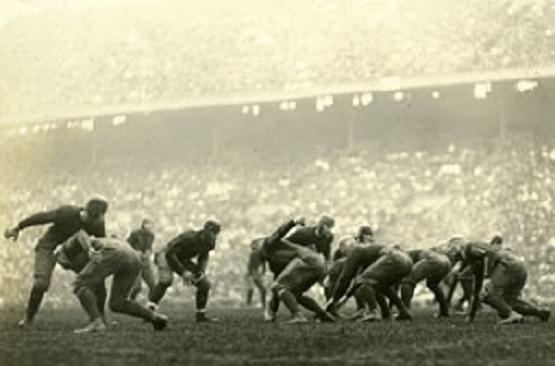
Pictured above is 1923's consensus mythical national champion (MNC), 8-0
Illinois, lining up against 7-1 Chicago in the first game played at
Illinois' Memorial Stadium. Despite a steady rain, 60,000
fans showed up to watch Illinois win their biggest game of the year
7-0, the legendary Red Grange scoring the touchdown.
In addition to Illinois, 3 other big-time schools went 8-0: Michigan, Cornell, and Yale. I summarized all 4 and compared them in detail in my 1923 national championship article.
My conclusion? Cornell #1, Illinois #2, Yale #3, and Michigan #4. You
can get detailed reasoning in the linked article, but in brief:
- Cornell outperformed Illinois against comparable opponents. They beat 8-1 Dartmouth 32-7 on the road, while Illinois beat 7-1
Chicago 7-0 at home. Cornell won 14-7 at 5-4 Penn, a game that was not
as close as the score, and Illinois won 9-6 at 5-3 Iowa. Cornell beat
Colgate 32-7, Illinois beat Ohio State 9-0 (a game that was closer than
the score), and Colgate tied Ohio State.
- Yale was lucky to beat
Maryland, who will not make this top 25 (or top 33), 16-14 at home, a
worse performance than any by Cornell and Illinois, and unlike Cornell
and Illinois, Yale did not defeat a top 10 opponent (or give any team
its only loss).
- I believe that Yale would have been ranked
higher than Michigan in a 1923 AP poll. Michigan also had 3 weak
performances, 2 more than each of the other 3 MNC contenders.
Cornell #1, Illinois #2, Yale #3, and Michigan #4.
#5: California, Notre Dame, Chicago, Syracuse, or Dartmouth?
I
think the next 5
teams in a 1923 AP poll would have been 9-0-1 California, 9-1 Notre
Dame, 7-1 Chicago, 8-1 Syracuse, and 8-1 Dartmouth, in that order.
9-0-1 California
hadn't lost a game since 1919, extending their unbeaten streak this
year to 38 games. The streak would end in 1925 at 50 games, the 2nd
longest in major college football history. Cal's tie this year was very
ugly, coming to a bad 2-3-3 Nevada team, but they closed out the season
with a trio of wins over top 25 caliber opponents: 13-7 at 6-2 Southern Cal (will be ranked #15), 9-0 over 10-1-1 Washington (#11), and 9-0 over 7-2 Stanford (#24).
7-1 Chicago did not take an upset, as their loss came at 8-0 Illinois (#2), so their relevant record
was effectively half a game better than Cal's, but the only top 25
caliber team Chicago defeated was 3-3-1 Wisconsin (will be #23), and
they only won 13-6 at home. So Cal can be ranked higher than Chicago.
8-1 Notre Dame, on the other hand, I can not see being rated higher
than Chicago. Notre Dame performed very impressively this season, but
they lost 14-7 at 4-2-2 Nebraska (#19), and like Chicago they only beat
one top 25 opponent (13-0 over 6-2-1 Army, #12, in Brooklyn). That win
was more impressive than Chicago's win over Wisconsin, but it doesn't
come close to making up for the fact that Notre Dame took an upset loss
and Chicago did not.
But other than Chicago being moved ahead of Notre Dame, these teams
can be ranked as a 1923 AP poll likely would have rated them. Like
Notre Dame, 8-1 Syracuse took an upset loss, falling 16-7 to 6-2-1
Colgate (#14) at home. Like Cal, they defeated 3 top 25 opponents, 5-4
Pittsburgh (#20), 6-2-1 Penn State (#16), and 4-2-2 Nebraska (#19), and
they also beat 7-2-1 Alabama 23-0. I would be inclined to rate Syracuse
higher than Notre Dame, who beat only 1 top 25 team, and who lost at
Nebraska, where Syracuse won. However, Syracuse's home 16-7 loss to
Colgate was arguably worse than Notre Dame's 14-7 loss at Nebraska, and
Syracuse barely beat 5-4 Pitt 3-0, whereas all 9 of Notre Dame's wins
came by more than a touchdown. And finally, Notre Dame's 13-0 win over
#12 Army in Brooklyn was more impressive than any of Syracuse's wins.
8-1
Dartmouth took their loss to #1 Cornell, while Notre Dame and Syracuse
each took an upset loss, but unlike Notre Dame and Syracuse, Dartmouth
did not beat any top 25 caliber teams, or anyone that was even close.
Dartmouth also did not perform very well, losing 32-7 to Cornell, and
barely beating a couple of "unrated" opponents.
California #5, Chicago #6, Notre Dame #7, Syracuse #8, and Dartmouth #9.
Chicago
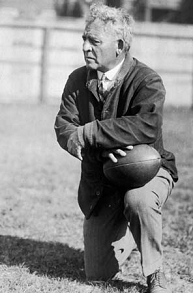
Chicago
had been a power team for more than 2 decades, but the sun was setting
on their time. Legendary Hall of Fame coach Amos Alonzo Stagg
(pictured) had been at the helm since way back in 1892, and through
1923 he was 195-72-20 at Chicago with 6 conference titles and 2 MNCs.
But this season would be Chicago's last finishing in a top 10. In 1924
Stagg and Chicago went 4-1-3, shared a 7th Big 10 title, and I have
them ranked #23. That would be their last appearance in the top 25.
So
after 1924, had the game passed Amos Alonzo Stagg by? It's impossible to say, since
the real problem was that Chicago was de-emphasizing football in the
1920s, and Stagg had to field teams under much more stringent academic
and eligibility rules than his Big 10 contemporaries did. Stagg went a
poor 25-39-5 at Chicago 1925-1932, after which he was forced out
because he was considered to be too old (he was 70 by then). He was
replaced by another Hall of Fame coach, Clark Shaughnessy, who did even
worse, 17-34-4 1933-1939, after which Chicago dropped their football
program altogether. Shaughnessy moved on to Stanford and promptly went
10-0 and won a share of the MNC in 1940. So yes, the problem was Chicago, not the coaches.
On
the other hand, after he was forced out at Chicago, Stagg started
coaching at Pacific, where he went just 60-77-7 in 14 seasons. So at
some point the game did pass him by. Overall, Stagg was 244-111-27 in
41 seasons at Chicago, and 314-199-35 in 57 seasons at 3 schools. That
is a very long career.
Minnesota, Washington, Army, Navy, Colgate, and Southern Cal
I'm thinking that the next teams to line up in a 1923 AP poll would have been the following, in this order:
5-1-1 Minnesota, 10-1-1 Washington, 6-2-1 Army, 5-1-3 Navy, 6-2-1
Colgate, and 6-2 Southern Cal. And I see no reason to change any of
that.
5-1-1 Minnesota lost at 8-0 Michigan (#4), and they were
tied at 3-3-1 Wisconsin (#23). 10-1-1 Washington lost at 9-0-1 Cal
(#5), and they were tied by 5-1-3 Navy (#13) in the Rose Bowl.
Washington was generally much more impressive than Minnesota this
season, and I would rank them higher, but their upset tie came in their
finale, and a bowl game, giving it greater emphasis, and Minnesota's
tie came on the road, so I can give this one to the hypothetical AP
poll voters of 1923.
6-2-1 Army also tied 5-1-3 Navy (#13) in
their finale. Their losses came to #3 Yale and #7 Notre Dame. They did
not beat a top 25 opponent, but their wins were impressive (average
score in those games 38-2). 5-1-3 Navy obviously finished strong with
those ties to 10-1-1 Washington and 6-2-1 Army, but they also tied
3-3-1 Princeton (unranked) in Baltimore, and they took an upset loss as
well, falling 21-3 at 6-2-1 Penn State (#16).
6-2-1 Colgate
pulled off a huge win in their finale, 16-7 at 8-1 Syracuse (#8), but
they were tied at 3-4-1 Ohio State (#26-33), and more critically, they
lost 9-0 at 5-1-3 Navy, which is why they fall behind Navy here. Their
other loss came to #1 Cornell. Other than the listed games, their
schedule was worthless, so the big win at Syracuse was really all they
accomplished this season. As for 6-2 Southern Cal, their one win of
value came 14-7 at 7-2 Stanford (#24), which paled considerably
compared to Colgate's one accomplishment. USC's losses came to #5 Cal
and #11 Washington. USC wouldn't have been rated this highly if not for
a Rose Bowl win over Penn State the previous season that put them on
the football map.
Minnesota #10, Washington #11, Army #12, Navy #13, Colgate #14, and Southern Cal #15.
Navy
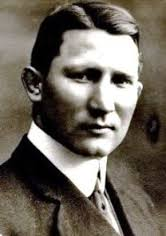
Navy
was headed up by the most underrated coach in college football history,
Bob Folwell (pictured). He is not in the Hall of Fame, which is
ridiculous, because more than a hundred coaches with worse records are
in the Hall of Fame. The NCAA forgot about him too, because his career
record of 109-31-9 should put him on the list for top all-time major/FBS coaching win
percentage, yet somehow he is not on the NCAA's winning percentage list.
Overlooked.
Folwell had been a halfback for Penn 1904-1907. He
started his coaching at Lafayette, going 22-4-1 there 1909-1911 and
fielding top 25 caliber teams all 3 years. Then he moved on to
Washington & Jefferson and went 36-5-3 1912-1915, including stellar
10-0-1 and 10-1 finishes in 1913 and 1914. He fielded top 25 caliber
teams all 4 years there. Next was his alma mater, and he went 27-10-2
at Penn 1916-1919, fielding top 25 caliber teams every season yet
again. Then he came to Navy, where he went 24-12-3 1920-1924. Through
this season, his teams had finished as top 25 caliber teams in every
one of his 15 years of coaching. That streak would finally be broken in
1924, his last year coaching college football.
Folwell moved on
to the pros. He was the first-ever coach for the New York Giants in
1925. He won a league title as coach of the Philadelphia Quakers in
1926. Then he coached the Atlantic City Roses in 1927. But that was the end
of the line for Folwell. He suffered from a hip infection, had surgery
on it in January of 1928, and he died 2 days later. And for some
reason, one of the greatest coaches of all time then sank into obscurity.
West Virginia, Penn State, Washington & Jefferson, and Nebraska
I think 7-1-1
West Virginia would have been rated next, but I'm going to go with
6-2-1 Penn State, who tied them in a big game at Yankee Stadium. This
was a very close call. Both teams took an upset loss in their finale,
West Virginia losing to 7-1-1 Washington & Jefferson (discussed
next) 7-2 at home, and PSU getting drubbed 20-3 at 5-4 Pitt (#20). West
Virginia won 13-7 at Pitt early in the season. They also put up some
huge scores, and outperformed PSU by a bit. But the big difference here
is that PSU defeated a higher-ranked team, #13 Navy, and they won big,
21-3. That gave Penn State a relevant record that was effectively a
game better than West Virginia's. PSU's other loss came to #8 Syracuse.
As for 7-1-1 Washington & Jefferson, they may have beaten West
Virginia in their finale, but they lost 13-6 at 5-4 Pitt (#20) and they
tied 6-1-2 Lafayette (#21), leaving them effectively a half game back
of West Virginia for the season despite the head to head win. Actually,
throw in West Virginia's tie with Penn State, who is rated higher than
W&J, and West Virginia was effectively a full game better than
W&J on the season. Washington & Jefferson likely would
have come into a 1923 AP poll behind West Virginia and Penn State, and
that is as it should be.
Then we have 4-2-2 Nebraska. They beat 9-1 Notre Dame (#7) 14-7,
knocking them out of MNC contention, and that was one of the biggest
wins by any team this season. But they took ties to a pair of unranked
teams, 5-0-3 Kansas and 2-3-3 Missouri. Their losses came to #2
Illinois and #8 Syracuse. Their straight record wasn't impressive, but
the one big win would have gotten them ranked about here, behind
Washington & Jefferson, in a 1923 AP poll, and that works fine.
#16 Penn State, #17 West Virginia, #18 Washington & Jefferson, and #19 Nebraska.
Washington & Jefferson
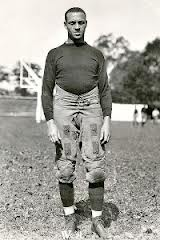 Washington
& Jefferson was coached by Hall of Famer John Heisman, who was here
for just this one season. Other than having an overhyped trophy named
after him, he is best known for going 102-29-7 at Georgia Tech
1904-1919 and winning an MNC in 1917. Washington & Jefferson had been strong for years (appearing the in the Rose Bowl and contending for an MNC in 1921),
and Heisman kept it going in his one season here. The Presidents went
7-1-1 this season, though Heisman only gets credit for 6-1-1. That's
because one of their wins came by way of a forfeit.
Washington
& Jefferson was coached by Hall of Famer John Heisman, who was here
for just this one season. Other than having an overhyped trophy named
after him, he is best known for going 102-29-7 at Georgia Tech
1904-1919 and winning an MNC in 1917. Washington & Jefferson had been strong for years (appearing the in the Rose Bowl and contending for an MNC in 1921),
and Heisman kept it going in his one season here. The Presidents went
7-1-1 this season, though Heisman only gets credit for 6-1-1. That's
because one of their wins came by way of a forfeit.
Washington
& Jefferson's best player was Charles "Pruner" West (pictured), and
the fact that he was black had caused some problems in previous years.
It was common for Northern schools to bench black players when playing
Southern schools, as a "courtesy," and West had been benched before,
but it had been a scarring experience for him and his teammates, and
Washington & Jefferson was done playing the "courtesy" game. This
year, when Washington & Lee came to play a game, they demanded that
West be held out, or they would not play. Heisman yelled back to the
opposing coach, "If you don't play, you lose!"
West actually had
a sprained ankle, and wasn't going to play anyway, but this was a
matter of principle. Interestingly, Heisman (who had attended Brown and Penn) had been on the other side
of the segregation fence for most of his coaching career. While he was
at Georgia Tech, a potential post-season game with Rutgers had been
nixed because Rutgers had a black player that they refused to bench.
Washington
& Lee made good on their threat not to play, giving Washington
& Jefferson a 1-0 "victory." But the real victory was Washington
& Jefferson standing their ground. Of course, the racists of
Washington & Lee were probably telling themselves the same thing
the next day. Pruner West became a doctor and practiced medicine for
nearly 50 years.
Lafayette and Pittsburgh
I would guess
that 6-1-2 Lafayette would have been rated next, but I'm going to go
with 5-4 Pittsburgh, who beat them 7-0. Pitt was incredibly erratic
this season, but they ended with a pair of big-time wins, 13-7 over
7-1-1 Washington & Jefferson (#18) and 20-3 over 6-2-1 Penn State
(#16), and that would have squeaked them into the bottom of a top 25 in
1923. They also took a pair of upset losses, 7-2 to 4-3-1 Carnegie
(unranked) and 6-0 at 5-4 Penn (#26-33). Their other 2 losses came to
#8 Syracuse and #17 West Virginia. The 2 upset losses were balanced out
by their pair of upset wins. Lafayette was similarly balanced, tying
Washington & Jefferson (#18) and Rutgers (will be ranked #22,
behind Lafayette). Pitt's head to head win over Lafayette holds sway,
and they should be ranked higher.
Lafayette had some good wins down the stretch, winning 8-6 at 5-4
Penn (#26-33) and 13-3 at 6-2-1 Lehigh (#26-33) in their finale.
Pittsburgh #20, Lafayette #21.
Stanford, Marquette, Colorado, Southern Methodist, Rutgers, and Wisconsin
Here's where
things get very cloudy as far as a hypothetical 1923 AP poll is
concerned. There are many candidates for the last 4 slots, but my best
guess as to who would have secured those slots is the following:
7-2 Stanford, 8-0 Marquette, 9-0 Colorado, and 9-0 Southern Methodist.
The last 3 teams, of course, didn't accomplish much, and would have
been getting token spots. Stanford didn't actually beat anyone of value
either, but they got
a lot of attention this season, relatively speaking, because Pitt coach
Pop Warner was slated to take over as head coach in 1924. He had sent
an assistant coach, Andy Kerr, to coach Stanford in his stead in 1922
and 1923, preparing the program for Warner's arrival. Stanford was
impressive in their wins this season (average score in those games
40-3), and they only lost to #15 Southern Cal 14-7. Their other loss
was 9-0 at #5 Cal.
However, a couple of teams had better
relevant records than all 4 of these candidates did. Let's start with
7-1-1 Rutgers. Their loss came to #17 West Virginia, and they tied #21
Lafayette. Since Lafayette is ranked higher than Stanford, Marquette,
Colorado, and SMU, that tie gave Rutgers an effective half game lead on
the season over those teams. Rutgers also beat 6-2-1 Lehigh (#26-33)
10-0, a better win than any of those teams accomplished. So we'll bring
Rutgers into this top 25 next.
Then there's 3-3-1 Wisconsin. An
ugly straight record, but the losses came to #2 Illinois, #4 Michigan,
and #6 Chicago, and the tie came to #10 Minnesota. The losses to
Michigan and Chicago were close, the Michigan one razor-close, and
Wisconsin could therefore be viably ranked all the way up into the top
10, ahead of Minnesota (who did not perform as well as Wisconsin).
Frankly, power-wise, that's where I suspect Wisconsin belongs. On the
other hand, they did not actually beat a good team, so a hypothetical
1923 AP poll has some reason to rate them much lower than that. Still,
the tie with Minnesota was far more than Stanford, Marquette, Colorado,
or SMU accomplished, so Wisconsin gets the nod over them.
That
leaves 2 slots open, and we'll hand those slots over to Stanford and
Marquette, who I believe would have been favored in a 1923 AP poll over
9-0 Colorado and 9-0 SMU. Stanford was a major team, while the other 3
teams were considered "mid-majors" at the time, comparable to WAC, MWC,
or CUSA teams today. Of those mid-major teams, Marquette got the most
attention, largely because of a 7-6 win at 7-1-1 Boston College (also a
mid-major team at this time, but a very good one, and ranked #26-33). The rest of their wins all came
by more than a touchdown.
Rutgers #22, Wisconsin #23, Stanford #24, and Marquette #25.
Rutgers
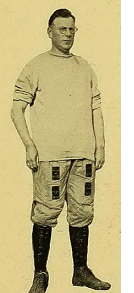
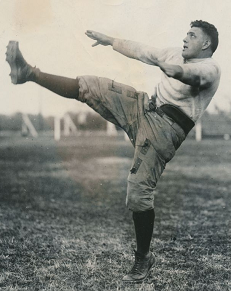
This
was the end of Rutgers' greatest football period, which isn't saying
much. Their football history has been decidedly thin. They've only
finished ranked 4 times since the AP poll started in 1936 (as of this
writing), and they didn't make any of my hypothetical AP poll top 25s
for 1924-1935. But prior to that, they were pretty good. 1923 was the
last season under Hall of Fame coach George Sanford (pictured above at
left), who went 56-32-5 at Rutgers 1913-1923, fielding top 25 caliber
teams at least 5 times, and top 10 teams in 1917 and 1918. Overall, he
was 84-46-6 at 3 schools.
The star was Homer Hazel (pictured
above at right), a nonconsensus All American at end this season and at
fullback the next season. He was quite big for his time, 5' 11" and 226
pounds. He is in the Hall of Fame.
Marquette
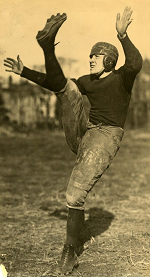
Marquette was headed by Hall of Fame coach Frank Murray, whom I covered in the Marquette section of my article on the 1935 top 25.
The star of the team was quarterback Red Dunne (pictured), who made a
3rd team All American list. Playing with a broken arm, Dunne led
Marquette to a late touchdown, then kicked the extra point that beat
7-1-1 Boston College 7-6. He became best known for his 8 year pro
career, culminating in 3 NFL titles for Curly Lambeau's Packers. Then
he returned to Marquette and served as Frank Murray's assistant coach
1933-1940. Dunne is in the Green Bay Packers and Wisconsin Sports Halls
of Fame.
Others
Receiving Votes
Here
are the teams closest to making this top 25. Three teams with perfect
records played schedules that were too small-time to make even this list: 9-0 New Mexico State, 7-0 Pacific, and 8-0 Davis & Elkins.
Colorado 9-0
9-0 Colorado won
all their games by more than a touchdown until their finale, when they
edged 5-2-1 Colorado State 6-3 on the road. Colorado State's other loss
came 10-0 at #6 Chicago, so Colorado may well have been a top 25 team
powerwise. The Rocky Mountain region was too weak to really know.
Colorado's other wins of note:
21-7 at 6-3 Denver and 17-7 over 6-1-1 Colorado College. We know, at
least, that Colorado was the best team in their state. But that's about
all we know.
Southern Methodist 9-0
Southern
Methodist was in the same boat as Colorado, a 9-0 champion of a weak
region. Colorado performed a bit better, though, and I'd rank them
ahead of SMU. SMU had 2 close wins, 10-3 over 7-2-1 Austin (who tied
Hardin-Simmons) and 13-6 over 6-2-1 Arkansas (who tied Ouachita). Their
big win came in their finale, 16-0 over 5-1-2 Baylor. Baylor tied 8-0-1
Texas (covered below), and that gave SMU the SWC title.
Iowa 5-3
Like 3-3-1
Wisconsin, who ended up #23, 5-3 Iowa may well have been a top 25 team.
But Wisconsin tied #10 Minnesota, and Iowa didn't do anything but lose
close games to good teams. They were edged 9-6 by #2 Illinois and 9-3
by #4 Michigan, and those are the results of a top 10 team. But they
were less hardy in a 20-7 loss at #10 Minnesota, and they struggled to
get by a pair of losing teams, 7-0 over 2-5-1 Purdue and 17-14 at 2-6
Northwestern in their finale. Iowa's best win was 20-0 at 3-4-1 Ohio
State (covered next).
Ohio State 3-4-1
Another Big 10
team that could viably be ranked in a top 25 for 1923, though this one
had a losing record. 3-4-1 Ohio State's losses came to 5-3 Iowa
(covered previously), #4 Michigan, #6 Chicago, and #2 Illinois. Their 3
wins came by big scores, and they tied #14 Colgate. But OSU didn't
accomplish anything other than the big tie with Colgate, and all 4 of
their losses came by more than a touchdown. The 20-0 loss to Iowa at
home was particularly egregious, because Iowa struggled to get by the
likes of 2-5-1 Purdue and 2-6 Northwestern.
Texas 8-0-1
8-0-1 Texas put
up some big scores for most of the season, including a 33-0 win over
6-3-1 Tulane and 16-0 over 5-2-1 Vanderbilt, but they faltered down the
stretch, delivering their weakest performances in their only 2 true
road games. They tied at 5-1-2 Baylor, giving 9-0 SMU (covered above) the SWC title, and they edged 5-3-1 Texas A&M 6-0 in their finale.
Boston College 7-1-1
7-1-1
Boston College was a mid-major at this time. They lost 7-6 at home to
#25 Marquette (8-0), a battle of 2 of the best "Little Big" teams. A
tie with 6-3-1 Vermont makes top 25 contention for BC seem highly
dubious, but all their wins came by more than a touchdown, and they did
beat some strong minor schools and mid-majors, including 21-0 over 8-1
Canisius, 14-0 over 10-1 Centenary, and 16-7 over 8-2 Holy Cross (who
beat Vermont 16-0).
Pennsylvania 5-4
5-4
Pennsylvania took a 3-0 home loss to 7-2-1 Maryland (unranked), but
they made up for it with a 6-0 win over 5-4 Pittsburgh (#20). Penn's
other losses came to #21 Lafayette, #16 Penn State, and #1 Cornell in
their last 3 games. The loss to Cornell came by 14-7, a terrific
performance given that that is the closest anyone had come to Cornell
in 3 years. Penn also beat 7-1-1 Centre (unranked) 24-0, another strong
performance. On the weak performance side, Penn only beat 5-2-1
Swarthmore 13-10 at home. Penn's opponents were an impressive 51-21-8
this year, and ranking Penn in a top 25 for this season would certainly
be viable.
Lehigh 6-2-1
6-2-1
Lehigh took their losses to #21 Lafayette and #22 Rutgers, and more
importantly they were tied at 4-4-1 Bucknell, which is what keeps them
out of serious contention for a top 25 spot. But they did beat 4-3-1 Carnegie
(who beat #20 Pitt) and 6-4 Brown.
1923
Top 25
1) Cornell 8-0
2) Illinois 8-0
3) Yale 8-0
4) Michigan 8-0
5) California 9-0-1
6) Chicago 7-1
7) Notre Dame 9-1
8) Syracuse 8-1
9) Dartmouth 8-1
10) Minnesota 5-1-1
11)
Washington 10-1-1
12) Army 6-2-1
13) Navy 5-1-3
14) Colgate 6-2-1
15) Southern Cal 6-2
16) Penn State 6-2-1
17) West Virginia 7-1-1
18) Washington & Jefferson 7-1-1
19) Nebraska 4-2-2
20) Pittsburgh 5-4
21) Lafayette 6-1-2
22) Rutgers 7-1-1
23) Wisconsin 3-3-1
24) Stanford 7-2
25) Marquette 8-0
Others
Receiving Votes:
Colorado 9-0
Southern Methodist 9-0
Iowa 5-3
Ohio State 3-4-1
Texas 8-0-1
Boston College 7-1-1
Pennsylvania 5-4
Lehigh 6-2-1




 Washington
& Jefferson was coached by Hall of Famer John Heisman, who was here
for just this one season. Other than having an overhyped trophy named
after him, he is best known for going 102-29-7 at Georgia Tech
1904-1919 and winning an MNC in 1917. Washington & Jefferson had been strong for years (appearing the in the Rose Bowl and contending for an MNC in 1921),
and Heisman kept it going in his one season here. The Presidents went
7-1-1 this season, though Heisman only gets credit for 6-1-1. That's
because one of their wins came by way of a forfeit.
Washington
& Jefferson was coached by Hall of Famer John Heisman, who was here
for just this one season. Other than having an overhyped trophy named
after him, he is best known for going 102-29-7 at Georgia Tech
1904-1919 and winning an MNC in 1917. Washington & Jefferson had been strong for years (appearing the in the Rose Bowl and contending for an MNC in 1921),
and Heisman kept it going in his one season here. The Presidents went
7-1-1 this season, though Heisman only gets credit for 6-1-1. That's
because one of their wins came by way of a forfeit.

